当前位置:网站首页>Using an example to understand the underlying processing mechanism of JS function
Using an example to understand the underlying processing mechanism of JS function
2020-11-06 20:53:00 【mttwind】
Personal notes , Please correct me if there is any mistake
Take the following code as an example , Run the parsing line by line
var x = [12, 23];
function fn(y) {
y[0] = 100;
y = [100];
y[1] = 200;
console.log(y);
}
fn(x);
console.log(x);
var x = [12, 23]; Run the following
- Open up heap memory , Create array values , Suppose the address of the heap memory is 0x000000
- Declare variables
x - assignment , the
xAddress to heap memory 0x000000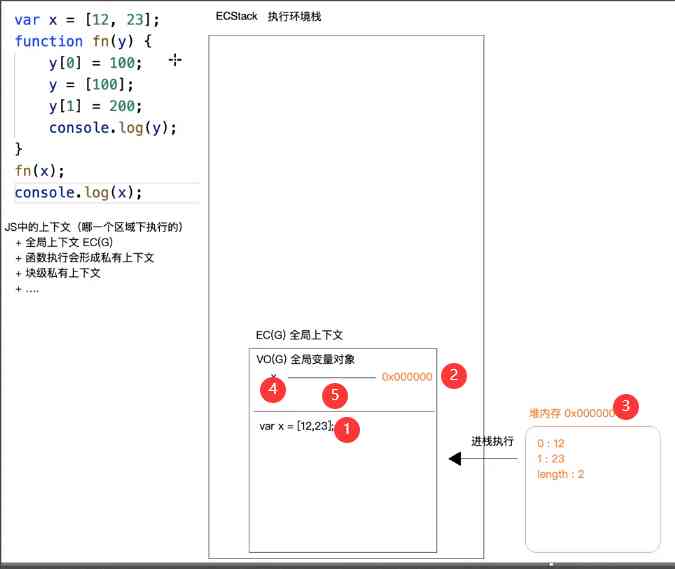
next
function fn(y) {
y[0] = 100;
y = [100];
y[1] = 200;
console.log(y);
}
Run the following
The above code is the process of creating a function . It's similar to creating a variable :
- They all declare a variable to store the value
- Same steps : The first step is to create a heap memory , There are functions in it , This heap has an address , Then assign the address to the variable
- Statement : In a similar way, function names are variables , When we declare functions
function fn(y){...}when , It's equivalent to declaring a variable , It's just that the value is a function . Be similar tovar fn = function (y){...}Function expression for . Finally, assign a function as a value to a variable or something else
So create a function , The detailed execution order is as follows
- Start with a heap of memory , Store the value of the function ( Suppose the address is 0x000001)
- The value of the object is in heap memory , It stores its key value pairs
- The value of the function is in heap memory , It's stored in its code , And it's stored in the form of strings
- When you create a function , It's a statement of its Scope (scope),scope The value is The context in which the function is currently created , That is, in which context , The scope is who
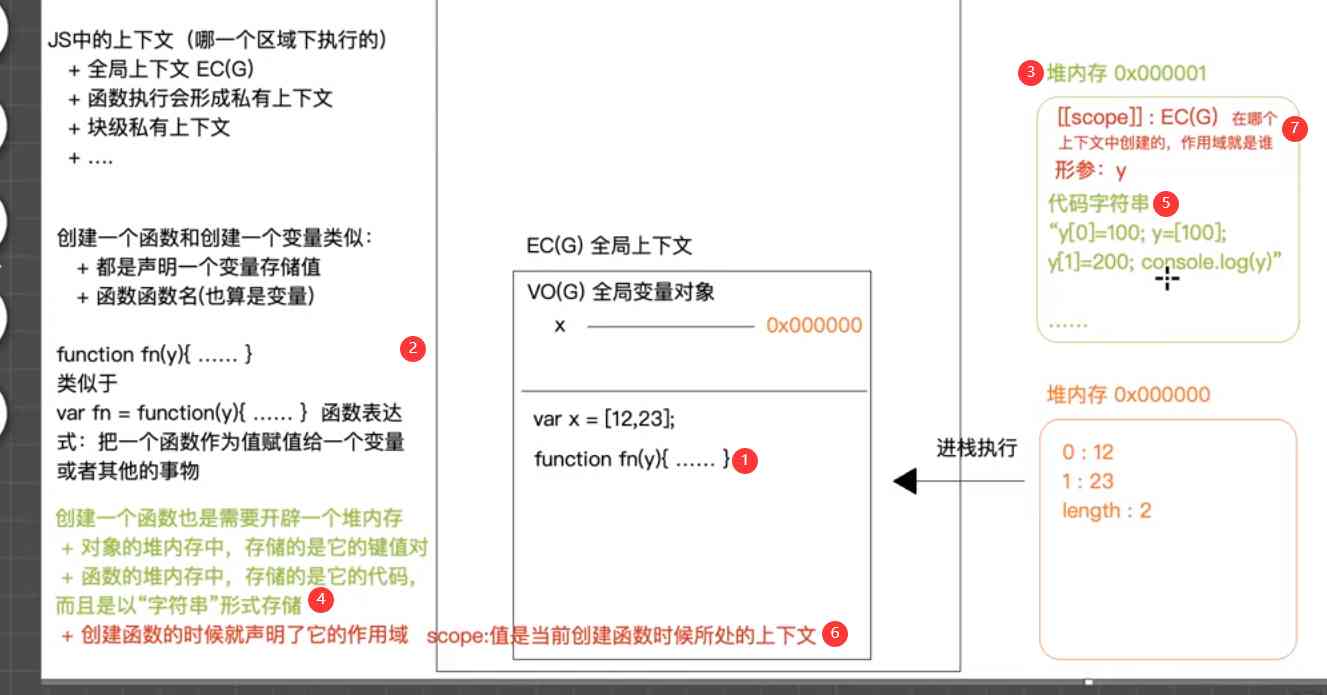
- Then declare the variable
fn, And point to the heap memory address ( Assuming that 0x000001)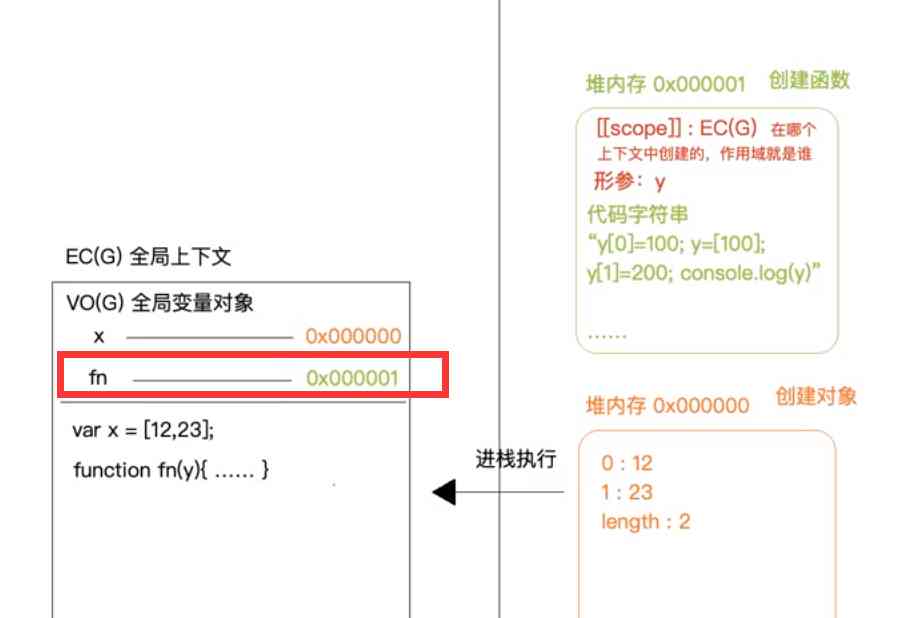
To perform a function
fn(x); Run the following ( To perform a function )
- Function execution time , The value is always passed on ,
fn(x)The message isxValue , namelyxPoint to the 0x000000 Heap memory address fn(0x000000)Form a brand new Private context EC(fn)- In the new context of function formation , Generate a private variable object AO, Used to store variables declared in the current context (Active Object The object of activity , abbreviation AO, A variable object , Similar to global variables in the global context )

- What happened before the internal code was executed
- Initialize scope chain scope-chain <EC(fn1),EC(G)>, At both ends of the chain are < Your current private context , The scope of the function ( The context in which the function was created )>, The right side of the chain is also called the current context ' Superior context '
- initialization this
- initialization argument
- In the current context , Declare a parameter variable , And assign the value of the argument passed to it
- Variable Promotion
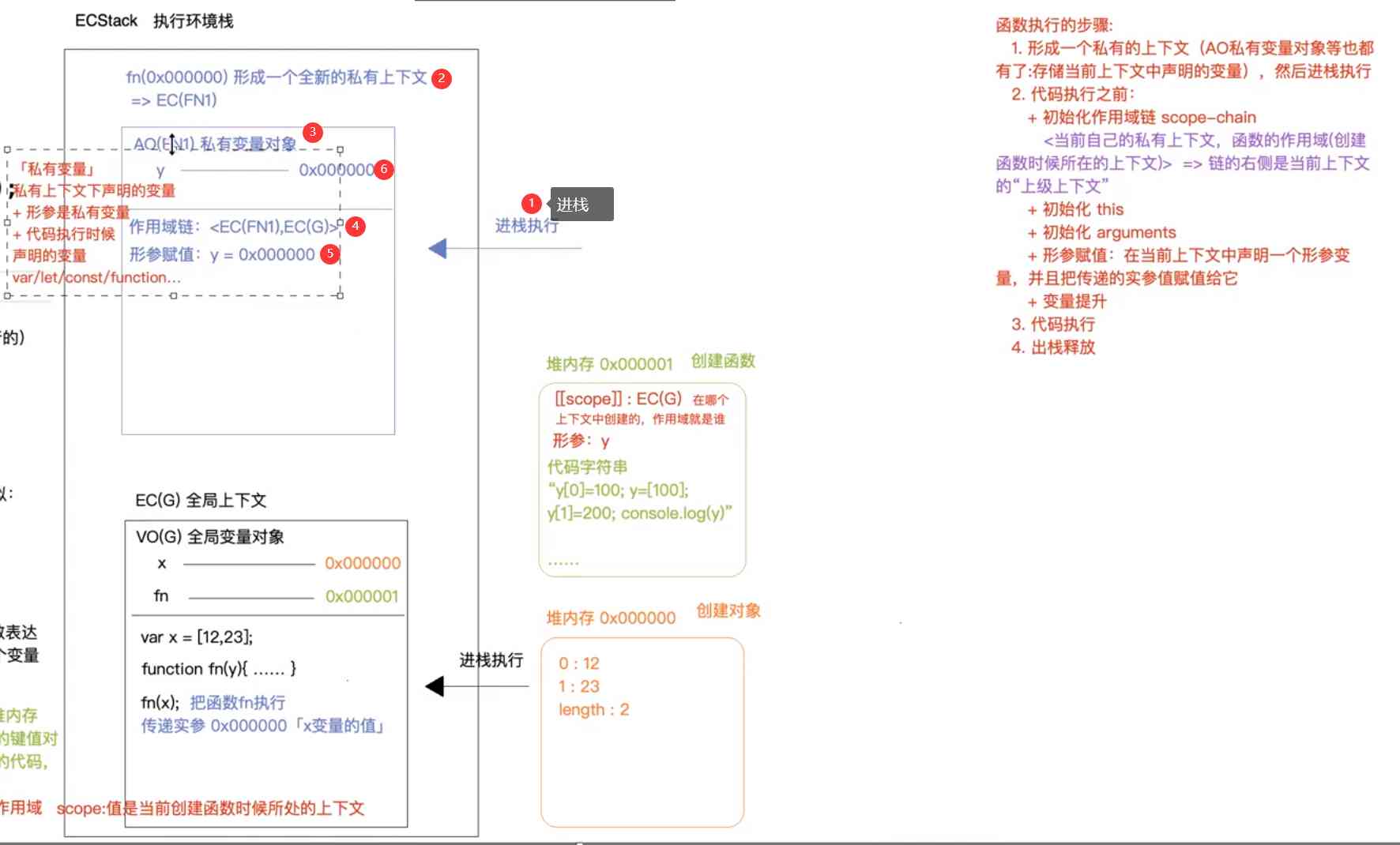
- Stack execution code
- Release from the stack
Function stack execution code detailed steps
Let's move on to the top 5 Step by step
Put the previously created function , The code string stored in heap memory is taken out and converted into line by line execution of code .
If a variable is encountered during code execution in private context , First of all, see if it's for your own ' Private variables ', If it is ' private ' Of , Then operate your own , There is no necessary relationship with the outside world , If it's not private , Based on Scope chain , To whom Superior context Search for , See if it is private in the context of the superior , If it's not , Continue looking up ...... Always find EC(G) Global context until , We call this search process Scope chain lookup mechanism therefore
y[0] = 100
y = [100]
y[1] = 200
It's done like this :
-
y[0] = 100,yNow the memory address stored is 0x000000, So change the value under this address :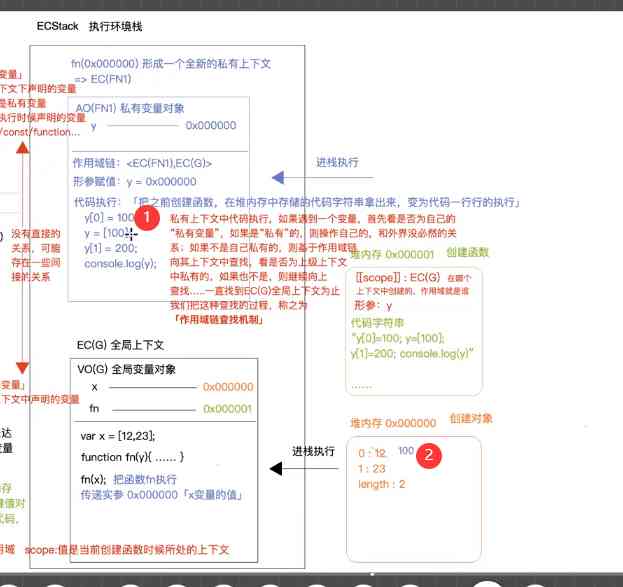
-
y = [100], New object values appear , So we need to open up new heap memory 0x000002, Create values , assignment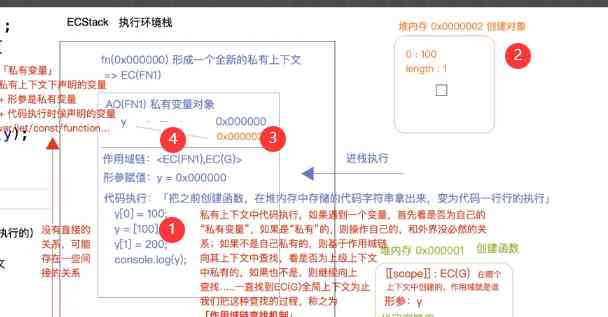
-
y[1] = 200, take 0x000002 Modify the value of the object corresponding to the address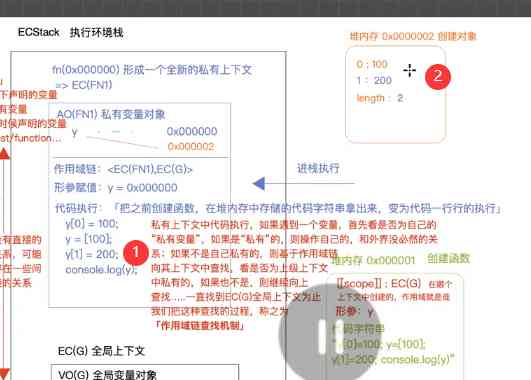
-
console.log(y);ThisyNamely 0x000002 Corresponding value[100,200]It operates on private variablesy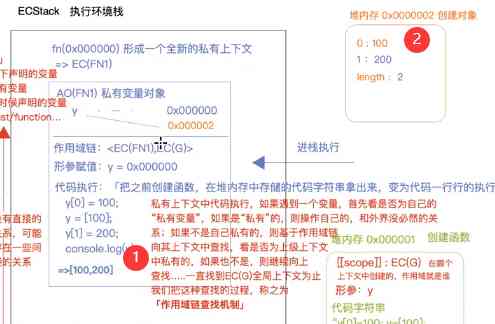
fn This completes the function .
And then execute the outside console.log(x);, At this time x In the global variable object x, The corresponding address is 0x000000, So output directly [100,23]
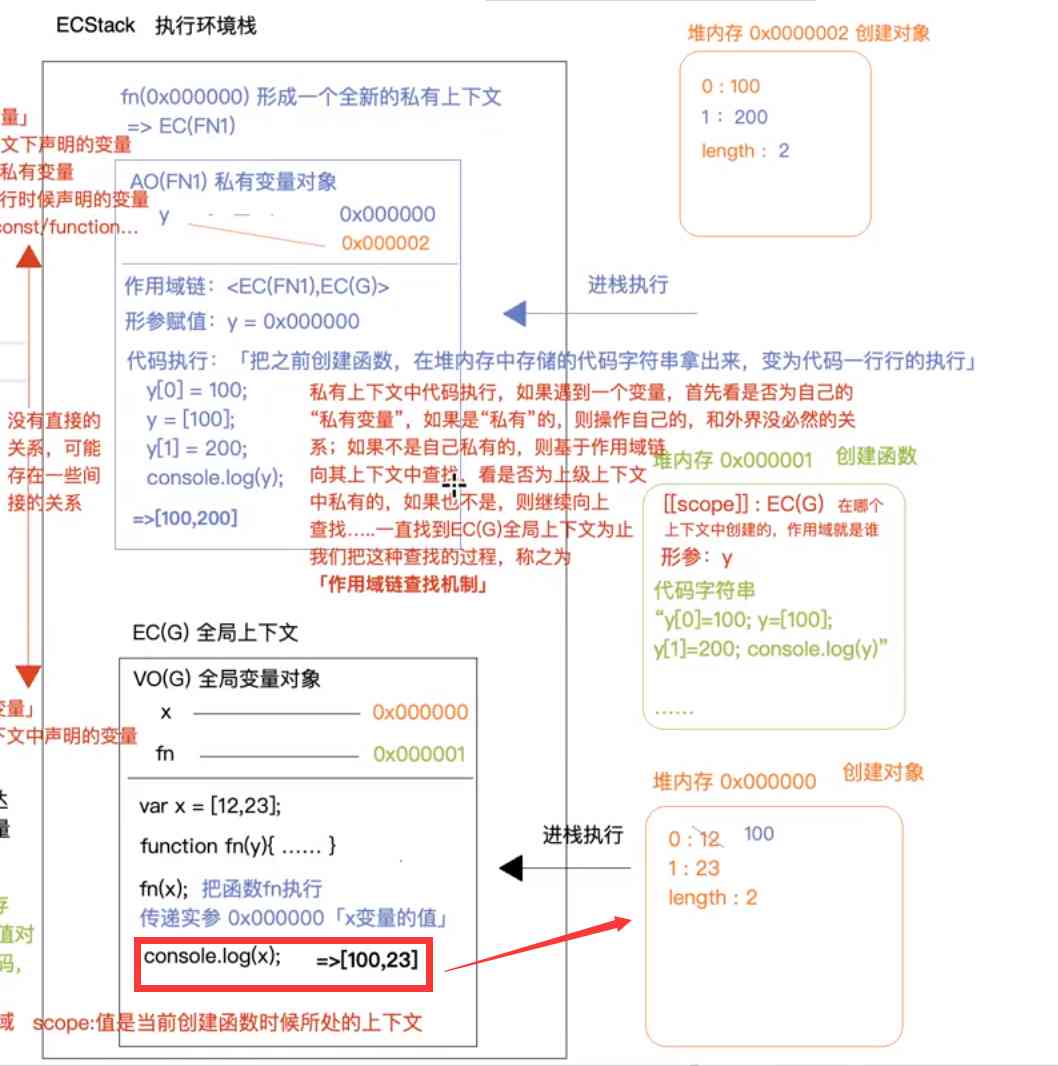
If fn After execution , Continue with other functions , It's going through the same process . Form a new context , Stack execution ... If there are so many functions , It's going to keep going up the stack , It's going to take up more and more memory . So in order to optimize , Browsers will default to many recycling mechanisms
Results and overall process
result

General flow chart
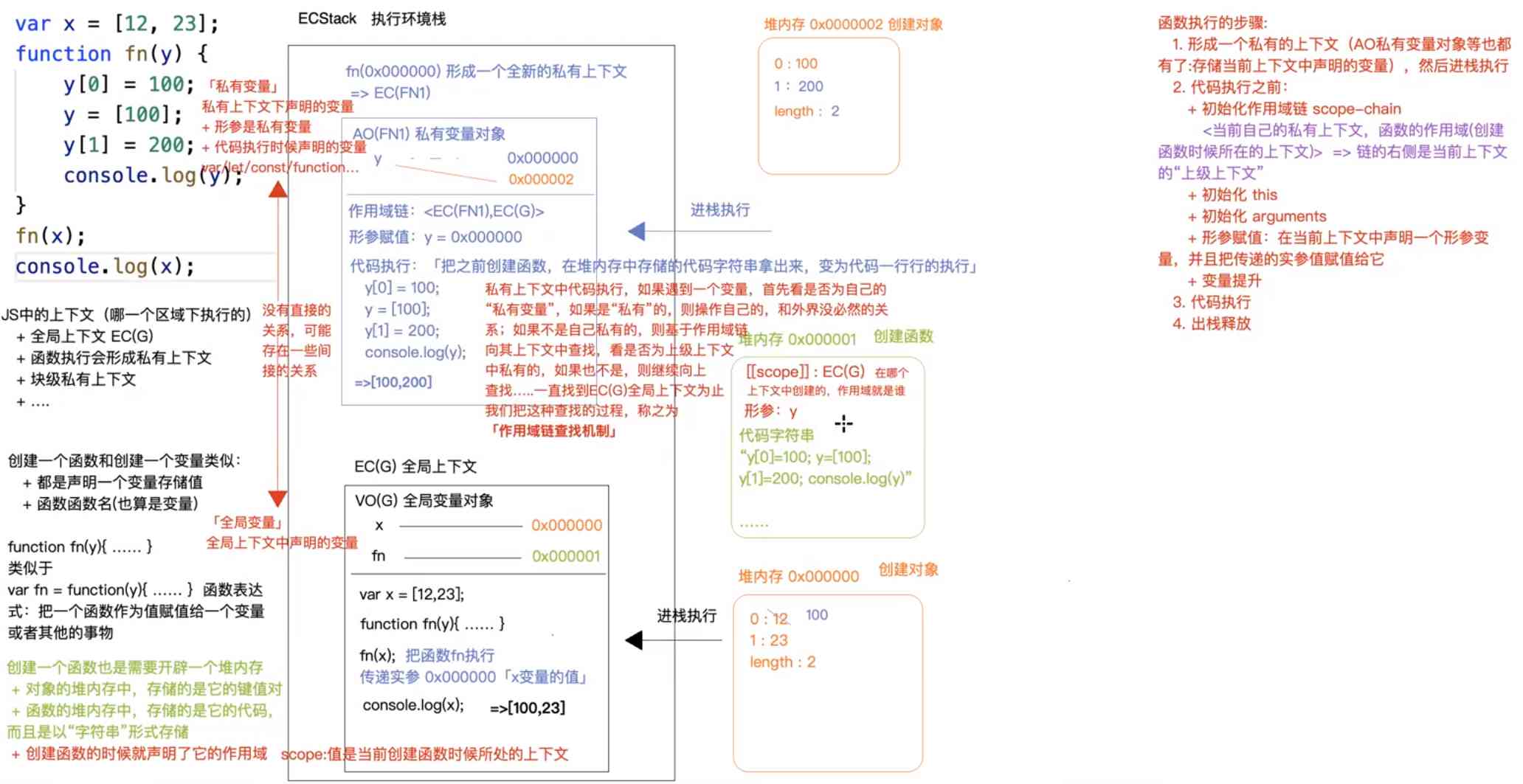
Other explanatory points
js Context classification
js Context ( Which area is executed ) classification
- Global context EC(G)
- Private context formed by function execution
- Block level private context
What are private variables
Private variables are variables declared by private context , contain
- Shape parameter
- Variables declared at the time of code execution
var/let/const/function... Note the difference from global variables , Not directly related , But there may be some indirect relationship , For example, the following code under the global variablexThe value of is 0x000000, By function , take 0x000000 Passed to private variablesy,yIt's also 0x000000
function fn(y) {
y[0] = 100;
y = [100];
y[1] = 200;
console.log(y);
}
fn(x)
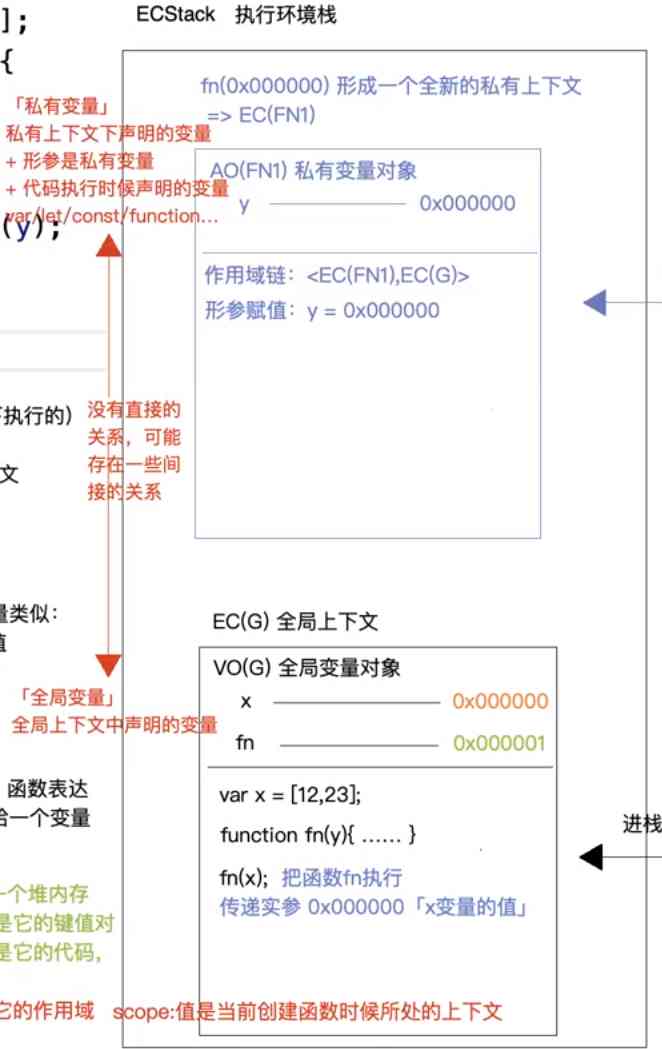
版权声明
本文为[mttwind]所创,转载请带上原文链接,感谢
边栏推荐
- 解决 WPF 绑定集合后数据变动界面却不更新的问题
- How to play sortable JS vuedraggable to realize nested drag function of forms
- The AI method put forward by China has more and more influence. Tianda et al. Mined the development law of AI from a large number of literatures
- What are the common problems of DTU connection
- (1) ASP.NET Introduction to core3.1 Ocelot
- 美团内部讲座|周烜:华东师范大学的数据库系统研究
- git远程库回退指定版本
- How to demote domain controllers and later in Windows Server 2012
- 使用 Iceberg on Kubernetes 打造新一代雲原生資料湖
- 华为云微认证考试简介
猜你喜欢

大数据处理黑科技:揭秘PB级数仓GaussDB(DWS) 并行计算技术

Axios learning notes (2): easy to understand the use of XHR and how to package simple Axios

It's time for your financial report to change to a more advanced style -- financial analysis cockpit

理解格式化原理

意派Epub360丨你想要的H5模板都在这里,电子书、大转盘、红包雨、问卷调查……

An article takes you to understand CSS pagination examples

image operating system windows cannot be used on this platform

Staying up late summarizes the key points of report automation, data visualization and mining, which is different from what you think

It is really necessary to build a distributed ID generation service

EOS founder BM: what's the difference between UE, UBI and URI?
随机推荐
PHP application docking justswap special development kit【 JustSwap.PHP ]
Even liver three all night, jvm77 high frequency interview questions detailed analysis, this?
How to play sortable JS vuedraggable to realize nested drag function of forms
Behind the record breaking Q2 revenue of Alibaba cloud, the cloud opening mode is reshaping
C + + and C + + programmers are about to be eliminated from the market
Staying up late summarizes the key points of report automation, data visualization and mining, which is different from what you think
Xmppmini project details: step by step from the principle of practical XMPP technology development 4. String decoding secrets and message package
The legality of IPFs / filecoin: protecting personal privacy from disclosure
Look! Internet, e-commerce offline big data analysis best practice! (Internet disk link attached)
JNI-Thread中start方法的呼叫與run方法的回撥分析
游戏开发中的新手引导与事件管理系统
Asp.Net Core learning notes: Introduction
消息队列(MessageQueue)-分析
意外的元素..所需元素..
2020年数据库技术大会助力技术提升
Try to build my mall from scratch (2): use JWT to protect our information security and perfect swagger configuration
hdu3974 Assign the task線段樹 dfs序
Elasticsearch Part 6: aggregate statistical query
GUI engine evaluation index
只有1个字节的文件实际占用多少磁盘空间